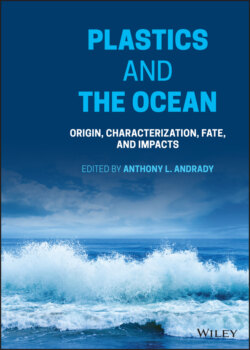Читать книгу Plastics and the Ocean - Группа авторов - Страница 26
1.6 Polymers: A Basic Introduction
ОглавлениеStructurally, all polymers have very long chain‐like molecules but their chemical formulae are relatively simple because often, the same structural unit repeats throughout the long molecular chain. For instance, polyethylene (PE), the plastic manufactured in the highest volume globally, has a long structural formula, a part of which may looks like the following:
It is merely a repetition of (‐CH2‐CH2‐) units placed end to end. Its structural formula is therefore, conveniently written as (‐CH2‐CH2) n , where n is the number of repeat units in the chain molecule, that can run into hundreds or thousands. As each repeat unit has a molecular weight of 28 (g/mol), that of the entire molecule is (28 × n) g/mol. Regardless of the length of the chain molecule, chemically, it is still a polyethylene. Since all PE molecules will not have identical chain lengths but different values of n, there is no unique molecular weight for polyethylene or for any other polymer (in contrast with simple organic molecule that have fixed molecular weights). Typically, a sample of a polymer is a mixture of structurally similar chains of different lengths and one can only refer to an average molecular weight for the entire distribution of molecules in the sample. Generally, two types of such averages, namely number‐average (M n in g/mol) and weight‐average (M W in g/mol), are used to express the molecular weights of plastics.
where N i is the number of chain molecules having a molecular weight, M i , and N is the total number of molecules in the sample (N = ∑N i ). Note that (N i M i )/M n ) is the weight fraction of molecules with a molecular weight M i .
However, the average molecular weight (M n ) is generally insufficient to fully describe the polymer as one can have the same average value of (M n ) for two samples of the same polymer with two very different distributions of chain lengths, as illustrated in Figure 1.11. The broadness of the distribution (called the polydispersity index D) is quantified as the ratio (M W /M N ). The value of D can vary from sample to sample, but the most probable value is D = 2. In addition to the average molecular weight and D, other variables such as branching of the linear chain or the amount of crystallinity contribute to the properties of the polymer.
